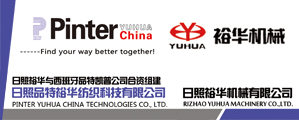States quo of China’s textile machinery industry (Q1-Q3, 2016)
Feb 15, 2017 | by Shen Da
In the first three quarters of 2016, the economic indicators of main business income, total profits ad others enjoyed a slight increase from a earlier in the textile machinery industry, while booth the imports and exports of textile machinery products showed a downward trend year-on-year, but the fixed asset investment saw a small increase.
Main indicators of the industry
Scale of the industry
The textile machinery industry realized main business income of 84.166 billion yuan, a year-on-year increase of 0.26%; total assets reached 98.565 billion yuan, up 3.80% from Jan. to Sept. of 2016.
Cost structure
In the first three quarters, gross cost amounted to 78.843 billion yuan, a slight increase of 0.30%. Among them, main business costs reached 71.304 billion yuan, up 0.59% year-on-year, with the highest proportion of 90.44% of the total; operating expenses amounted to 2.226 billion yuan, a year-on-year fall of 2.38%, with the proportion of 2.82%; management costs registered 4.416 billion yuan, down 2.82%, with the proportion of 5.60%; financial costs were 898 million yuan, an decrease of 0.73%, with the proportion of 1.18%.
Profitability
Total profits of the textile machinery industry realized 5.371 billion yuan ,an increase of 5.79%; the losses of loss-making enterprises amounted to 514 million yuan, an amazing plummet of 23.02%, with the scale of losses of 16.79%.
Investment
The fixed asset investment increased 1% to 21.012 billion yuan, with the proportion of 2.28% of the whole industry, up 7.62 percentage points year-on-year.
Overview of the key enterprises
According to the statistics of the key enterprises traced by China Textile Machinery Association, From Jan. to Sept., main business income of the key enterprises reached 28.608 billion yuan, a year-on-year decrease of 3.13%, with the proportion of 34.18% in the whole industry; total profits amounted 3.647 billion yuan, a fall of 10.93%, with the proportion of 68.22%. The losses of loss-making enterprises registered 208 million yuan, a slight fall of 0.90%; and the scale of losses reached 33.75%. The gross cost of those enterprises registered 30.255 billion yuan, down 0.07%, of which, main business costs arrived 23.018 billion yuan, down 0.92%, accounting for 76.50% of the gross cost; operating expenses amounted 1.887 billion yuan, up 5.38%, for 6.27%; management costs arrived 4.403 billion yuan, up 3.76%, for 14.66%; financial costs registered 781 million yuan, up 3.07%, for 2.58%. The gross cost of the textile machinery industry enjoyed a slight growth, while the key enterprises suffered significant burden in the three costs.
Imports and exports of textile machinery products
Chinese Customs released that China’s total exports and imports of textile machinery amounted to 4.136 billion dollar from Jan. to Sept., down 9.67% year on year. Among them, textile machinery realized exports of 2.236 billion dollar, falling by 5.70%; imports of 1.9 billion dollars, a fall of 13.93% year on year. (Table 1)
Import summary of textile machinery products
From January to Sept., China has imported textile machinery from 62 countries, with total imports of 1.9 billion dollars, down 13.93% year on year.
Imports of textile machinery products
In terms of different categories of imported products, the imports of auxiliary equipment as well as spare and accessory parts ranked the first with total imports of 423 million dollars, down 1.22% year on year, which accounted for 21.81% of total imports. Only the non-woven machinery and knitting machinery showed positive increase, with the growth of 24.73% and 4.19% year-on-year. (Table 2)
Major countries and regions for China’s imports of textile machinery
China’s imports of textile machinery are mainly from Germany, Japan, Italy, Belgium and China’s Taiwan Province, with total trade value of 1.535 billion dollars, down 15.57%, accounting for 80.83% of total imports. (Table 3)
Imports of textile machinery from Germany were in the first place, and the imports amounted to 622 million dollars, a significant drop of 30.80%. Among them, the knitting machinery reached trade value of 162 million dollars with a year-on-year decrease of 1.77%; only non-woven machinery enjoyed a positive increase by 2.04% year-on-year; while chemical fiber machinery suffered a massive decline of 59.38% year-on-year.
Overview of import regions in China
From January to September, China’s 29 provinces and autonomous regions have a different number of imports. Jiangsu, Zhejiang, Guangdong, Shanghai and Xinjiang ranked the top five in terms of total import value, accounting for 81.28%. Jiangsu Province ranked the first with total import value of 541 million dollars, with a whopping decline of 16.20%, accounting for 28.47%; Xinjiang autonomous region still maintained the previous five in imports, while the growth showed a slight decline. (Table 4)
Exports summary of textile machinery products
Total exports of textile machinery products reached 2.236 billion dollars, with a year-on-year decrease of 5.70%.
Exports of textile machinery products
The exports of textile machinery products of different categories from January to September are shown in Table 5.
The knitting machinery ranked first with exports of 727 million dollar, up 2.99% year on year, occupying 32.51%, which was followed by dyeing and printing as well as finishing machinery, auxiliary device as well as spare and accessory parts, weaving machinery, spinning machinery, chemical fiber machinery, and non-woven machinery. Weaving machinery showed the largest decline of 26.67% year-on-year.
Major trading partners in exports
China’s textile machinery were exported to 176 countries and regions, and the top five ones are shown in Table 6.
China’s exports in the top five ones accounted for 55.30%. Exports to India amounted to 489 million dollars with an increase of 0.54%, accounting for 21.88% of total exports.
Overview of export regions in China
China’s 31 provinces and autonomous regions have a different number of exports. As for total export value, the top five ones accounted for 78.66%. (Table 7)
To sum up, in the situation of complex economic environment, the economic operation of the textile machinery industry continued to slow in the first three quarters, of which each indicator remained low, as well as the imports and exports of textile machinery products showed a year-on-year decline. 2016 is the first year of the “13th Five-Year”, when textile machinery industry has entered the structural adjustment and development period according to its operation of the three quarters, with the industry expansion rate keeping slowing. For domestic textile machinery market, xinjiang, Ningxia and other areas are supported by national and local policies, so the textile enterprises continue to expand investment in new capacity, becoming a hot spot of textile machinery market. The rising costs prompt structural adjustment of China’s textile industry, so in order to cope with the market changes, textile enterprises expand investment on technology and equipment transformation, and intelligent manufacturing, extending to the high-end value chain. In recent years, the domestic large-scale textile equipment manufacturing enterprises gradually extended to the downstream service, to provide maintenance and support of the whole life cycle of the textile enterprises, personalized design, e-commerce, as well as the overall solution and other forms of service.
For the international market, South Asia, India, Bangladesh, Vietnam, Pakistan, Indonesia of Southeast Asia and other countries are still major destinations for China’s textile exports. Since the textile industry plays an important role in the national economy, they continue to introduce policies and measures to support the development of textile industry, and construct textile processing industrial park to attract foreign investment. In addition to strengthen its own traditional advantages of spinning and garment processing industry, they gradually develop related industries and textile industry chain, so all kinds of textile equipment exist important market opportunities in the new capacity and in the process of equipment upgrades.
According to the operation of the first three quarters of the textile machinery industry, and combining with the current situation of the domestic and international market, it’s expected that the annual growth of indicators will continue to develop steadily, and export growth faces a large pressure to be positive, but the exports will still exceed imports.
Table 1: Total Imports and Exports of China’s Textile Machinery (Jan. - Sept.,2016)
Unit: USD
|
Name of indicators |
Total volume |
Total value |
Y-O-Y value | |
|
Total Imports and Exports |
18,023,377 |
4,135,572,827 |
20.24 |
-9.67 |
|
Imports |
1,482,174 |
1,899,595,783 |
-1.85 |
-13.93 |
|
Exports |
16,541,203 |
2,235,977,044 |
22.72 |
-5.70 |
Table 2: Imports of Textile Machinery (Jan. - Sept.,2016)
Unit: USD
|
Product categories |
Total value |
Proportion (%) |
Y-O-Y value |
|
Total |
1,899,595,783 |
100.00 |
-13.93 |
|
Auxiliary device as well as spare and accessory parts |
423,206,188 |
22.28 |
-1.22 |
|
Spinning machinery |
393,177,391 |
20.70 |
-6.24 |
|
Knitting machinery |
324,569,407 |
17.09 |
4.19 |
|
Dyeing and printing as well as finishing machinery |
268,127,167 |
14.11 |
-17.81 |
|
Weaving machinery |
255,300,449 |
13.44 |
-4.91 |
|
Chemical fiber machinery |
183,275,323 |
9.65 |
-55.46 |
|
Non-woven machinery |
51,939,858 |
2.73 |
24.73 |
Table 3: Overview of Major Countries and Regions
Unit: USD
|
Major countries and regions |
Total value |
Proportion (%) |
Y-O-Y value (±%) |
|
Total |
1,899,595,783 |
100.00 |
-13.93 |
|
Germany |
621,594,944 |
32.72 |
-30.80 |
|
Japan |
485,965,859 |
25.58 |
13.74 |
|
Italy |
236,804,609 |
12.47 |
-14.81 |
|
Taiwan Province |
106,076,179 |
5.58 |
-16.53 |
|
Belgium |
85,005,813 |
4.47 |
-3.36 |
|
Others |
364,148,379 |
19.17 |
-6.28 |
Unit: USD
|
Provinces & Cities |
Total value |
Proportion (%) |
Y-O-Y value (±%) |
|
Total value |
1,899,595,783 |
100.00 |
-13.93 |
|
Jiangsu |
540,897,831 |
28.47 |
-16.20 |
|
Zhejiang |
407,995,448 |
21.48 |
-23.03 |
|
Guangdong |
276,658,296 |
14.56 |
18.27 |
|
shanghai |
151,719,186 |
7.99 |
114.16 |
|
Xinjiang |
166,761,940 |
8.78 |
-3.87 |
|
others |
355,563,082 |
18.72 |
-35.74 |
Unit: USD
|
Product categories |
Total value |
Proportion (%) |
Y-O-Y value |
|
Total |
2,235,977,044 |
100.00 |
-5.70 |
|
Knitting machinery |
726,828,844 |
32.51 |
2.99 |
|
Dyeing and printing as well as finishing machinery |
427,370,245 |
19.11 |
2.22 |
|
Auxiliary device as well as spare and accessory parts |
403,178,564 |
18.03 |
-12.40 |
|
Weaving machinery |
249,484,219 |
11.16 |
-26.67 |
|
Spinning machinery |
239,569,169 |
10.71 |
-9.25 |
|
Chemical fiber machinery |
128,565,198 |
5.75 |
0.27 |
|
Non-woven machinery |
60,980,805 |
2.73 |
11.69 |
Unit: USD
|
Major countries and regions |
Total value |
Proportion (%) |
Y-O-Y value |
|
Total |
2,235,977,044 |
100.00 |
-5.70 |
|
India |
489,311,073 |
21.88 |
0.54 |
|
Bangladesh |
277,596,198 |
12.41 |
-5.35 |
|
Vietnam |
242,088,015 |
10.83 |
3.19 |
|
Pakistan |
116,733,413 |
5.22 |
-12.00 |
|
Turkey |
110,686,470 |
4.95 |
35.80 |
|
others |
999,561,875 |
44.70 |
-12.50 |
|
provinces & cities |
Total value |
Proportion (%) |
Y-O-Y value |
|
Total |
2,235,977,044 |
100.00 |
-5.70 |
|
Jiangsu |
555,094,006 |
24.83 |
-0.48 |
|
Zhejiang |
533,192,574 |
23.85 |
-10.99 |
|
Guangdong |
283,938,006 |
12.70 |
2.89 |
|
shanghai |
278,947,641 |
12.48 |
-1.11 |
|
Shandong |
138,265,163 |
6.18 |
3.90 |
|
others |
446,539,654 |
19.97 |
-14.66 |








